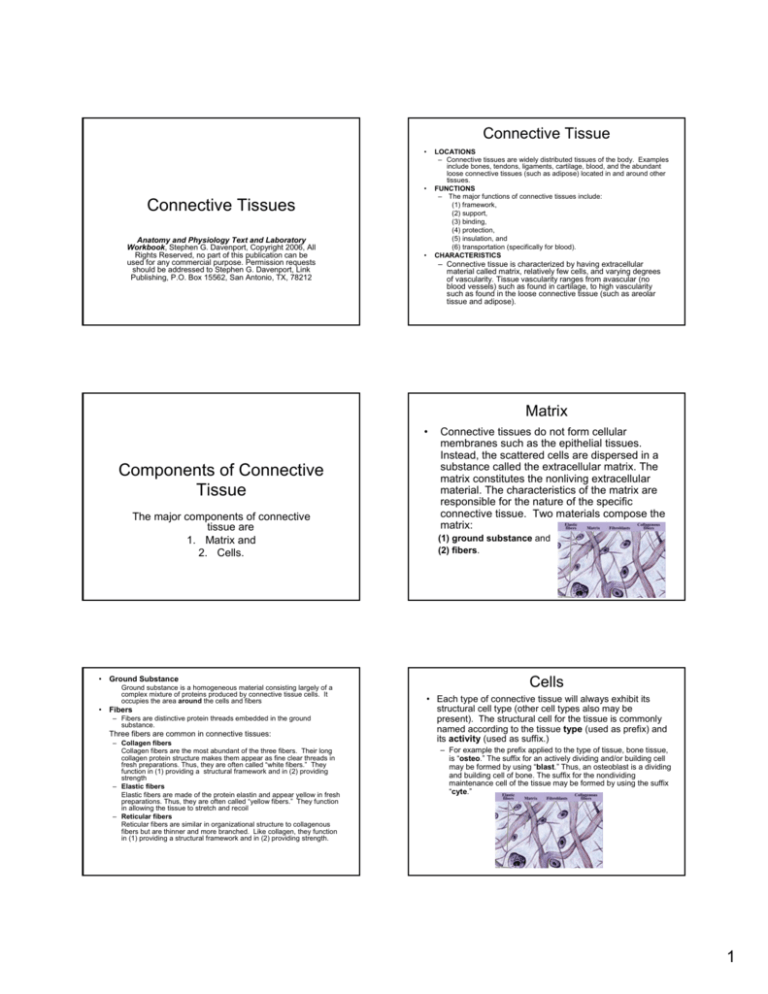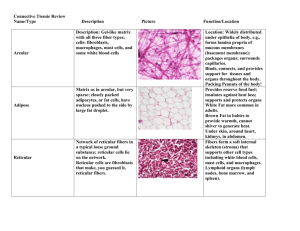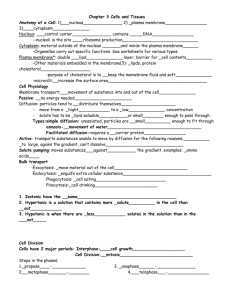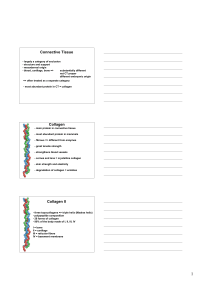
Connective Tissue
•
•
Connective Tissues
Anatomy and Physiology Text and Laboratory
Workbook, Stephen G. Davenport, Copyright 2006, All
Rights Reserved, no part of this publication can be
used for any commercial purpose. Permission requests
should be addressed to Stephen G. Davenport, Link
Publishing, P.O. Box 15562, San Antonio, TX, 78212
•
LOCATIONS
– Connective tissues are widely distributed tissues of the body. Examples
include bones, tendons, ligaments, cartilage, blood, and the abundant
loose connective tissues (such as adipose) located in and around other
tissues.
FUNCTIONS
– The major functions of connective tissues include:
(1) framework,
(2) support,
(3) binding,
(4) protection,
(5) insulation, and
(6) transportation (specifically for blood).
CHARACTERISTICS
– Connective tissue is characterized by having extracellular
material called matrix, relatively few cells, and varying degrees
of vascularity. Tissue vascularity ranges from avascular (no
blood vessels) such as found in cartilage, to high vascularity
such as found in the loose connective tissue (such as areolar
tissue and adipose).
Matrix
•
Components of Connective
Tissue
The major components of connective
tissue are
1. Matrix and
2. Cells.
• Ground Substance
Ground substance is a homogeneous material consisting largely of a
complex mixture of proteins produced by connective tissue cells. It
occupies the area around the cells and fibers
• Fibers
– Fibers are distinctive protein threads embedded in the ground
substance.
Three fibers are common in connective tissues:
– Collagen fibers
Collagen fibers are the most abundant of the three fibers. Their long
collagen protein structure makes them appear as fine clear threads in
fresh preparations. Thus, they are often called “white fibers.” They
function in (1) providing a structural framework and in (2) providing
strength
– Elastic fibers
Elastic fibers are made of the protein elastin and appear yellow in fresh
preparations. Thus, they are often called “yellow fibers.” They function
in allowing the tissue to stretch and recoil
– Reticular fibers
Reticular fibers are similar in organizational structure to collagenous
fibers but are thinner and more branched. Like collagen, they function
in (1) providing a structural framework and in (2) providing strength.
Connective tissues do not form cellular
membranes such as the epithelial tissues.
Instead, the scattered cells are dispersed in a
substance called the extracellular matrix. The
matrix constitutes the nonliving extracellular
material. The characteristics of the matrix are
responsible for the nature of the specific
connective tissue. Two materials compose the
matrix:
(1) ground substance and
(2) fibers.
Cells
• Each type of connective tissue will always exhibit its
structural cell type (other cell types also may be
present). The structural cell for the tissue is commonly
named according to the tissue type (used as prefix) and
its activity (used as suffix.)
– For example the prefix applied to the type of tissue, bone tissue,
is “osteo.” The suffix for an actively dividing and/or building cell
may be formed by using “blast.” Thus, an osteoblast is a dividing
and building cell of bone. The suffix for the nondividing
maintenance cell of the tissue may be formed by using the suffix
“cyte.”
1
Classification
• Connective tissue classification is based upon
three structural characteristics of the matrix:
CLASSIFICATION
Three structural characteristics of the matrix:
(1) the types of fibers,
(2) the type of ground substance, and
(3) the structural arrangement.
– (1) the types of fibers,
– (2) the type of ground substance, and
– (3) the structural arrangement.
• According to these characteristics of the matrix,
connective tissues are classified into four types:
–
–
–
–
(1) connective tissue proper,
(2) cartilage,
(3) bone, and
(4) blood.
Connective Tissue Proper
• The matrix of connective tissue proper is
characterized
– (1) by being flexible,
– (2) by having a viscous ground substance, and
– (3) by having abundant fibers.
• The structural cells are called fibroblasts. The
two subclasses of connective tissue proper are
– (1) loose connective tissue and
– (2) dense connective tissue.
Loose Connective Tissue
– Loose connective tissue is characterized by having a
loose arrangement of fibers. It includes the following
three tissues:
• (1) areolar,
• (2) adipose, and
• (3) reticular.
Dense Connective Tissue
– Dense connective tissue is characterized by having
a dense arrangement of fibers. It includes the
following three tissues:
• (1) regular,
• (2) irregular, and
• (3) elastic.
Cartilage
• The matrix of cartilage is characterized
– (1) by being semisolid and flexible and
– (2) by having abundant collagenous fibers. Elastic
cartilage also has elastic fibers.
• The structural cells are named according to their
activity are chondroblasts or chondrocytes.
• According to the characteristics of the matrix,
cartilage is divided into three types:
– (1) hyaline,
– (2) elastic, and
– (3) fibrocartilage.
Bone
• The matrix of bone is characterized by being
–
–
–
–
(1) rigid,
(2) strong, and by containing
(3) calcium salts and
(4) collagen fibers.
• The structural cells are named according to their
activity, osteoblasts or osteocytes.
• According to the characteristics of the matrix,
bone is divided into two types:
– (1) compact and
– (2) spongy (cancellous).
2
Blood
• The matrix of blood is characterized by
being a
– (1) viscous fluid with
– (2) no formed fibers.
THE LOOSE CONNECTIVE
TISSUES
• In bone marrow the formative ancestral
cells are named hemocytoblasts; in blood
the mature cells are named leukocytes
(white blood cells) and erythrocytes (red
blood cells).
Areolar Tissue
Structure
•
The matrix of areolar tissue consists of abundant
collagenous, elastic, and reticular fibers. The fibers are
dispersed in an abundant viscous ground substance.
• The ground substance is viscous because it contains
abundant glycoproteins and mucopolysaccharides
(proteoglycans) such as hyaluronic acid.
• The structural cells of areolar tissue are fibroblasts.
Other cell types include mast cells (produce histamine)
and macrophages (leukocytes which function in
phagocytosis).
Lab Activity 7Areolar Tissue
• Observe a tissue
preparation labeled
“Areolar Tissue.”
Identify, the
– (1) collagenous fibers
(wavy, usually pink to red
stained),
– (2) elastic fibers (small,
usually blue stained), and
– (3) open “spaces” (where
the semifluid ground
substance was located
prior to tissue processing). Fig. 8.38
Areolar Tissue
• Locations
– Areolar is widely distributed throughout the body. It
is found attaching and supporting many tissues and
organs. For example, it attaches the skin to
underlying tissues, surrounds and supports many
organs, such as blood vessels and glands.
• Functions
– The tissue functions in (1) attaching, and (2)
supporting tissues and organs.
Areolar Tissue
• Areolar tissue (100x)
has scattered
fibroblasts and a
loose arrangement of
fibers. The structural
cells of the tissue are
fibroblasts. Mast cells
are commonly
associated with this
tissue.
Fig. 8.39
3
Adipose Tissue
Adipose Tissue
• Structure
• Locations
– The matrix of mature adipose tissue is small in
quantity and is usually not observed in mature tissue
preparations. The fibers of the matrix are collagenous
and elastic fibers. The fibers form a network between
adipocytes giving the tissue strength and flexibility.
Fibroblasts are associated with the fibers. Adipocytes
are the dominate cells and store neutral fats
(triglycerides) in a lipid droplet. As the lipid droplet
enlarges, the cytoplasm and nucleus are forced to the
periphery of the cell.
Lab Activity 8Adipose Tissue
• Observe a tissue preparation
labeled “Adipose Tissue.” The
lipid droplets were removed
during processing and their
locations are seen as large clear
areas. The pattern of these
large clear areas often gives the
tissue a net-like appearance.
• Identify the location of the lipid
droplets and cytoplasm. As the
lipid droplet increases in size,
the cytoplasm becomes more
peripherally located (between
the lipid droplet and the plasma
Fig. 8.40
membrane.)
Developing Adipose Tissue
• A whole mount (wm)
of developing adipose
tissue shows small
adipocytes
surrounded by matrix.
The matrix contains a
viscous ground
substance, collagen
fibers, and reticular
fibers.
–
Adipose is widely distributed in the body, especially
subcutaneously and around internal organs.
• Functions
– Adipose tissue functions (1) as a reserve energy
source, (2) as an insulator from heat loss, and (3)
structurally supports and (4) cushions organs.
Adipose Tissue
• Adipocytes are the
dominate cells of mature
adipose tissue (100x).
The small quantity of
matrix is compressed
between the large
adipocytes, which show
large cleared areas.
These areas contained
droplets of triglycerides
prior to tissue processing.
Fig. 8.41
Reticular Connective Tissue
• Structure
– The matrix of reticular connective tissue
consists of a network of thin, delicate, highly
branched reticular fibers with a small quantity
of ground substance. The structural cells are
fibroblasts that are called reticular cells.
Fig. 8.42
4
Lab Activity 9Reticular Tissue
Reticular Connective Tissue
• Location
– Reticular tissue is located in the liver, lymph nodes,
spleen, and the bone marrow.
• Functions
– Reticular tissue functions in forming the supporting
framework of soft organs (the liver, lymph nodes, and
spleen) and is found in bone marrow. Because the
reticular cells (fibroblasts) are distributed among the
functional cells of the organ, they are difficult to
differentiate.
• Observe a tissue
preparation labeled
“Reticular Tissue,” or
“Lymph node.”
Identify the short,
highly branched
reticular fibers which
are usually stained
dark blue.
Fig. 8.44
Reticular Tissue
• Reticular connective
tissue from a lymph
node. Reticular fibers
are seen as short
branching fibers.
THE DENSE CONNECTIVE
TISSUES
Fig. 8.45
Dense Regular Connective Tissue
• Structure
– The matrix of dense regular connective tissue
consists of dense bundles of parallel (regular
arrangement) collagenous fibers. The bundles of
collagenous fibers are surrounded by a small quantity
of ground substance. The structural cells are called
fibroblasts and are found in rows between bundles of
collagenous fibers.
• Locations
– Dense regular connective tissue is mostly found
forming (1) tendons and (2) ligaments.
• Functions
– The tissue functions in providing for (1) attachments
and (2) great tensile strength. Tendons attach muscle
to bone, and ligaments attach bone to bone. The
collagen fibers of tendons and ligaments provide
great tensile strength and resist stretching when
tension is applied end-to-end.
5
Lab Activity 10 –
Tendon (Dense Regular)
• Observe a tissue
preparation labeled
“Tendon,” (or “White
Fibrous Connective
Tissue”). Identify the
lightly stained parallel
collagenous fibers. The
collagen fibers may
appear wavy. Identify the
rows of fibroblasts
located between bundles
Fig. 8.46
of collagen fibers
Dense Irregular Connective Tissue
• Dense regular
connective tissue, a
tendon (100x),
consists of abundant
collagenous fibers
and rows of
fibroblasts.
Fig. 8.47
Dense Irregular Connective Tissue
• Location
Tissue locations include
• Structure
– The matrix of dense irregular connective
tissue consists mostly of irregularly arranged
collagenous fiber bundles with a small
quantity of ground substance. An irregular
arrangement means that the bundles (groups
of collagenous fibers) are interwoven in many
directions.
Lab Activity 11 Dense Irregular Connective Tissue
• Observe a tissue
preparation labeled
“Dense Irregular
Connective Tissue,” or
“Skin.” If observing the
skin, the thick layer of
dense irregular
connective tissue is the
layer underlying the
epidermis, the surface
layer of stratified
squamous epithelium.
Tendon (Dense Regular)
– (1) the dermis (skin) and
– (2) connective tissue sheets surrounding muscles
(fasciae) and some
– (3) organs such as the liver and lymph nodes.
• Functions
– The irregular arrangement of collagenous fibers
provides
– (1) structural support
– (2) organization and
– (3) great tensile strength in many directions.
Fibroblasts are dispersed among the bundles of
collagenous fibers.
Dense Irregular Connective Tissue
Dermis of Skin
• Dense irregular
connective tissue
located in the dermis
of the skin.
Fig. 8.49
Fig. 8.48
6
Dense Irregular Connective Tissue
Dermis of Skin
• Dense irregular
connective tissue
located in the dermis
of the skin.
Fig. 8.50
Elastic Connective Tissue
• Structure
Elastic connective tissue may be considered a
special type of dense regular connective tissue.
This is because its matrix consists mostly of
densely arranged elastic fibers, not collagenous
fibers. Scattered collagenous fibers are located
in small spaces among the elastic fibers.
Fibroblasts are found throughout the tissue.
Lab Activity 12 –
Elastic Connective Tissue
Elastic Connective Tissue
• Locations
Elastic connective tissue locations include the
–
–
–
–
(1) vocal cords,
(2) walls of large arteries,
(3) walls of respiratory airways such as the trachea and bronchi, and
(4) the ligamentum nuchae (a flat ribbon-like elastic ligament that
connects the vertebrae of the neck of the back of the skull).
• Functions
Elastic connective tissue functions in providing considerable
• (1) strength,
• (2) stretch, and
• (3) recoil.
Elastic Connective Tissue
• The wall of an elastic
artery consists of
abundant elastic tissue.
The elastic tissue
consists of abundant
elastic fibers and
fibroblasts. The elastic
tissue is mostly located in
layers between the fibers
of smooth muscle.
Fig. 8.52
•
Observe either the tissue
preparation of an “Artery,
Vein, and Nerve,” or a
preparation labeled
“Elastic Connective
Tissue.”
• Artery (elastic)
Elastic connective tissue
is found in the walls of
Fig. 8.51
elastic arteries. In this
location the elastic tissue
is found situated among
smooth muscle fibers.
Elastic Connective Tissue
(ligamentum nuchae)
• Observe a tissue
preparation labeled “Elastic
Connective Tissue.”
Preparations of “elastic
connective tissue” are
usually from the
ligamentum nuchae, the
flat ribbon-like strong
elastic ligament that
connects the vertebrae of
the neck to the back of the
skull.
Fig. 8.53
7
Elastic Connective Tissue
(ligamentum nuchae)
• Elastic connective
tissue from the
ligamentum nuchae
consists predominately
of large elastic fibers.
Collagen fibers are
found situated in areas
around the elastic
fibers.
CARTILAGE
Fig. 8.54
Cartilage functions as a
(1) supportive and
(2) structural connective tissue.
Cartilage
Hyaline Cartilage
• Its thickness is limited because it is avascular.
• The matrix is semisolid and slightly flexible and
consists mostly of collagen fibers embedded in
a protein ground substance.
• The structural cells of mature cartilage are
chondroblasts.
• A membrane of dense irregular connective
tissue, called the perichondrium, forms the
surface of most cartilage.
• Structure
•
The matrix of hyaline cartilage is firm and resilient. It
consists of abundant collagenous fibers embedded in
ground substance and appears amorphous (with no
definite form). The structural cells are called
chondroblasts. A small cavity called a lacuna surrounds
each cell. A connective tissue layer called the
perichondrium surrounds all hyaline cartilage except the
cartilage’s articular surfaces. The perichondrium helps to
support and protect the hyaline cartilage. Hyaline
cartilage is avascular and without nerves.
Hyaline Cartilage
• Locations
•
Hyaline cartilage is widely distributed
throughout the body. Its locations include (1)
where the ribs connect to the sternum (called
costal cartilage), (2) the ends of long bones
(called articular cartilage), (3) the tip of the nose,
and (4) the framework of larger respiratory
airways.
• Functions
•
Hyaline cartilage functions in providing (1)
support, (2) a structural framework, and (3)
cushioning.
Lab Activity 13 –
Hyaline Cartilage
• Observe a tissue
preparation labeled
“Hyaline Cartilage.”
Hyaline cartilage
preparations usually
show the tissue as part of
an organ, like the
trachea. Locate the
perichondrium, the
supportive layer of dense
irregular connective
tissue (abundant collagen
fibers) at the surface of
the cartilage.
Fig. 8.55
8
Hyaline Cartilage
• Hyaline cartilage
consists of
collagenous fibers
embedded in a firm
amorphous ground
substance. The
structural cells of
developing cartilage
are chondroblasts.
Fibrocartilage
• Structure
– The matrix of fibrocartilage consists of
dense, compact, collagenous fiber bundles
with little ground substance. The fiber
bundles usually appear wavy and are nearly
parallel with chondroblasts located along their
surface.
Fig. 8.56
Lab Activity 14
Fibrocartilage
Fibrocartilage
• Locations
Fibrocartilage locations include
– (1) the intervertebral discs (fibrocartilage discs) that
separate the vertebrae,
– (2) part of the knee joint and
– (3) the symphysis pubis (connects the two pubic
bones).
• Functions
Fibrocartilage functions include
– (1) providing strength and
– (2) resisting compression
• Observe a tissue
preparation labeled
“Fibrocartilage.”
Preparations are
usually made from the
internal structure of
the tissue; thus, the
external tissue, the
perichondrium, is
usually not shown.
Fibrocartilage
Fig. 8.57
Elastic Cartilage
• Structure
• Fibrocartilage (100x)
consists of bundles of
collagenous fibers
embedded in a small
quantity of ground
substance. The
structural cells are
chondroblasts.
Fig. 8.58
– The matrix of elastic cartilage consists of abundant
collagenous and elastic fibers embedded in a small
quantity of ground substance. The matrix, like hyaline
cartilage would be amorphous if not for the presence
of the distinctive elastic fibers.
– The matrix provides structure and resists
compression.
– The structural cells, the chondroblasts, are distributed
among the fibers.
– Small cavities, the lacunae, surround the
chondroblasts.
9
Elastic Cartilage
• Locations
The locations of elastic cartilage include the
– (1) external ear and the
– (2) epiglottis (cartilage structure that closes the
opening to the airway when swallowing food).
• Functions
Elastic cartilage functions include providing
– (1) support,
– (2) framework, and
– (3) flexibility.
Lab Activity 15 –
Elastic Cartilage
• Observe a tissue
preparation labeled
“Elastic Cartilage.”
Preparations of elastic
cartilage will either be of
the complete tissue
located within an organ
(like the epiglottis), or a
tissue section that shows
only the internal structure.
Fig. 8.59
Elastic Cartilage
• The matrix of elastic
cartilage (100x)
consists of elastic and
collagenous fibers
embedded in ground
substance. The
primary cells of the
tissue are
chondroblasts.
BONE (OSSEOUS TISSUE)
Fig. 8.60
BONE
• Structure
•
The matrix of bone consists of about one-third collagenous
fibers and two-thirds calcium salts. The calcium salts make bone
tissue hard, and the collagenous fibers give it strength. The mature
cells of bone embedded in the matrix are called osteocytes. Boneforming cells (osteogenic cells) are called osteoblasts, and bone
destroying cells are called osteoclasts. Osteoblasts and
osteoclasts are located in areas where bone is being modified by
building and/or destruction.
• The two structural types of bone tissue are
– (1) compact and
– (2) spongy.
• The central (Haversian) canal contains blood vessels and
occasionally a nerve. Each Haversian canal is surrounded by
lamellae (concentric rings of matrix) separated by rows of
osteocytes. Small canals called canaliculi pierce the matrix.
Canaliculi are pathways for branches of the osteocytes. By the
interconnection of their branches, the osteocytes maintain a
connection with the blood vessels located in the Haversian (central)
canal. Spongy bone is organized into plates called trabeculae.
The matrix of bone consists of
about one-third collagenous fibers
and two-thirds calcium salts.
BONE
• Location
Bone tissue forms bones, the framework of the
skeleton.
• Function
Bones function in
– (1) providing protection,
– (2) serving as attachment sites for muscles and
connective tissues,
– (3) providing reserves for minerals,
– (4) blood cell production (marrow), and
– (5) providing a site for fat deposit (yellow marrow).
10
Lab Activity 16
Ground Compact Bone
• Observe a tissue preparation
of compact bone labeled
“Bone, ground.” The
preparations are thick; DO
NOT USE HIGH POWER OR
OIL IMMERSION for
observations. The term
“ground” means that the bone
was prepared by polishing
(grinding) to give it a smooth
surface for observation.
Identify the Haversian
systems, each with its
centrally located Haversian
Fig. 8.61
(central) canal.
Ground Compact Bone
• Each Haversian
system contains a
centrally located
Haversian (central)
canal. In the matrix
are concentric rows of
osteocytes. Small
Fig. 8.62
canals, the canaliculi,
contain branches of
the osteocytes.
Compact Bone - Demineralized
• Demineralized bone
tissue (100x) shows
numerous osteocytes
surrounded by
collagen fibers.
BLOOD
The matrix of blood is the fluid
component called plasma.
Fig. 8.63
BLOOD
Blood
– The matrix of blood is the fluid component called
plasma. The plasma, consisting mostly of water,
transports dissolved substances such as nutrients,
wastes, hormones, etc. Also, plasma transports the
formed elements.
– The formed elements consist of cells called
erythrocytes (red blood cells) and leukocytes (white
blood cells), and cell fragments called platelets.
• Locations
Blood is located within the cardiovascular
system (heart and the blood vessels). Blood
circulates through a system of blood vessels
(vascular system). Arteries are vessels that carry
blood away from the heart, and veins carry
blood toward the heart. The smallest blood
vessels are the capillaries that serve as sites of
exchange between the blood and the interstitial
fluid.
• Structure
11
Blood
Functions
Blood functions include
– (1) transportation of substances such as respiratory gases
(oxygen and carbon dioxide), nutrients, wastes, hormones,
antibodies, etc. and
– (2) provides protection against disease (immunity) and
– (3) protects from blood loss by its clotting mechanism.
• Erythrocytes function mostly in the transport of oxygen.
Erythrocytes also transport some carbon dioxide,
however, most carbon dioxide is transported in ionic
form in the plasma.
• Leukocytes are involved in protection of the body from
disease (phagocytosis, antibody production, cell-to-cell
interactions, etc.).
• Platelets function in stopping blood loss (clotting) by
forming a plug at the site of vascular injury.
Lab Activity 17
Blood
• A human blood smear
shows the formed
elements, the
erythrocytes (RBCs),
leukocytes (WBCs), and
platelets. Erythrocytes do
not have nuclei. A
leukocyte has a single
nucleus and its cytoplasm
may contain granules.
Fig. 8.64
Blood
• Blood (430x) consists of a
matrix called plasma and
the formed elements. The
formed elements include
two major groups of cells,
the erythrocytes (RBCs)
and the leukocytes
(WBCs) and cell
fragments called
platelets.
Fig. 8.65
12








